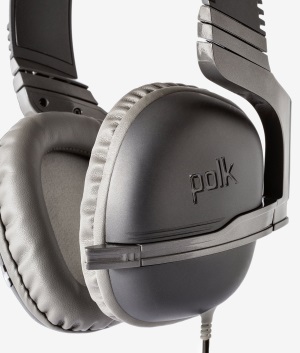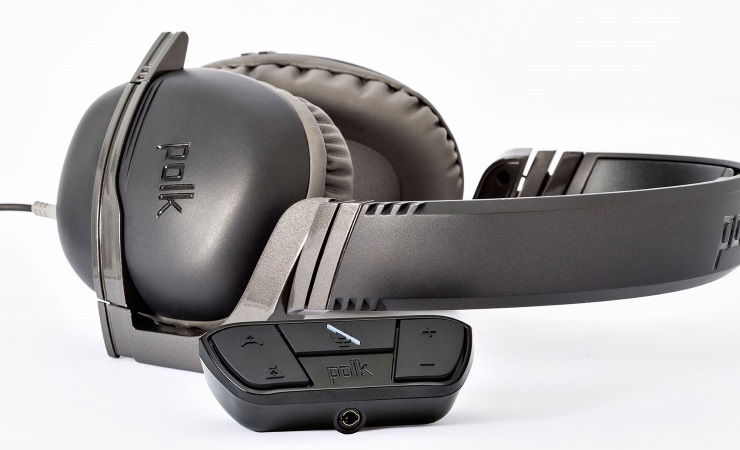Headsets for your console of choice come in all shapes and sizes these days. There is no one-size-fits-all mantra in this business, and, thankfully, we are not restricted to first party offerings, with console manufacturers opening up their systems and inviting hardware makers in to bring the best experience possible to headset buyers. Polk are one such company to try and take advantage of the growing console headset market, and they are a company few outside of the US will have dealt with until now. Before now, Polk have created audio gear for high end audiophiles, but have seen fit to release a series of console-centric audio products, and one of these is the Polk Audio Striker Zx Headset For Xbox One, which I have had the pleasure of using for the last two weeks.
The Striker Zx headset I tested came in a garish colour combo (off-white and luminescent orange), and that, coupled with its angular design and big puffy ear cups left me feeling all nostalgic as the headset looks like a piece of kit pulled straight from a 1980’s Argos catalog. I’m not slating the design, here – I actually kind of like it. Would I want you to see me wearing them? Probably not, but in the privacy of my own home, I look freakin’ awesome, dude.
 It’s aimed at the middle-tier of gaming budgets, and can be had for just under £100 on amazon at time of writing. Apart from the opinion dividing design, the cash gets you a headset that integrates seamlessly with the Xbox One’s core experience. The 3.5mm jack that sits at the end of the headset’s one metre cable plugs directly into the supplied controller mount, which has a total of 5 face buttons. The Striker Zx allows you to pipe your voice directly back into the ear cups, which is a nifty feature to stop you (or indeed your kids) from shouting too loudly at the TV when the on-screen action all becomes a little too much. The other face buttons handle game volume and chat volume respectively.
It’s aimed at the middle-tier of gaming budgets, and can be had for just under £100 on amazon at time of writing. Apart from the opinion dividing design, the cash gets you a headset that integrates seamlessly with the Xbox One’s core experience. The 3.5mm jack that sits at the end of the headset’s one metre cable plugs directly into the supplied controller mount, which has a total of 5 face buttons. The Striker Zx allows you to pipe your voice directly back into the ear cups, which is a nifty feature to stop you (or indeed your kids) from shouting too loudly at the TV when the on-screen action all becomes a little too much. The other face buttons handle game volume and chat volume respectively.
The microphone is mounted on the left ear cup, and is retractable, so you can hide it out of the way when it is not in use. The arm of the retractable mic is made of a durable pliable metal casing, and I didn’t have any trouble jamming the mic in and out whilst hopping between online parties. The headset is lightweight and comfortable, with enough padding to stop any discomfort from settling in even after a long session killing mofos.
Game audio is streamed wirelessly to the headset on Xbox One’s controller, with the only wire needed to connect the controller to the headset itself. There is a debate among audiophiles over how the Xbox One and PlayStation 4 deals with the compression of audio that is streamed to a controller mounted headset, but I didn’t find any compression related issues here. Audio delivery was smooth and clear, with very few audio artifacts that I would put down to some form of latent compression. While using the microphone and sound loopback feature, a quiet hissing can be heard if not a lot is happening in game, but I doubt this will be a problem for most online gamers.
Looking at the audio head on, the range the Striker Zx delivers is just about what I would expect from a headset in this price bracket. There is solid bass delivery, with explosions and booming soundtracks being handled reasonably well, without ever shaking my brain like a more premium headset might. The higher end of the spectrum is delivered well enough, and I can find little fault with the overall sound experience offered by its two drivers. While headsets with 5 or even 7 drivers are available, and offer a superior spatial experience, the Zx does just about enough to warrant the price tag.
Should you buy the Striker Zx, though? The answer to that question depends on your budget, patience, and how picky you are when it comes to audio products. For most, the £100 price bracket, comfort, ease of use, and solid audio performance will make for a no-brainer purchase. For those that have deeper pockets and a requirement for 5.1 audio with a more complicated set up (separate amps for wireless headsets are commonplace), you may need to keep looking.





